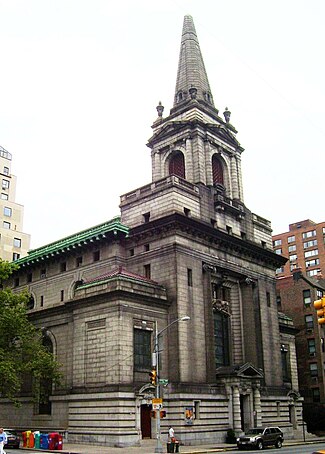First Church of Christ, Scientist (New York City)
First Church of Christ, Scientist | |
NYC Landmark No. LP-0833
| |
 Former building of the First Church of Christ, Scientist in Manhattan, New York City | |
| Location | 1 West 96th Street, Manhattan, New York City, New York, United States |
|---|---|
| Coordinates | 40°47′31.2″N 73°57′53.64″W / 40.792000°N 73.9649000°W |
| Built | 1903 |
| Architect | Carrère and Hastings |
| Architectural style | English Baroque, French Beaux-Arts |
| Part of | Central Park West Historic District (ID82001189[1]) |
| NYCL No. | LP-0833 |
| Significant dates | |
| Added to NRHP | November 9, 1982[1] |
| Designated NYCL | July 23, 1974[2] |
The First Church of Christ, Scientist in Manhattan is an historically landmarked 1903 building located at Central Park West and 96th Street in Manhattan, New York City. The building is designated New York City landmark.[3]
Architecture
The building, designed by Carrère & Hastings, was completed in 1903, is described by New York Times architectural historian Christopher Gray as "one of the city's most sumptuous churches."[4] The style reminiscent of the churches of Nicholas Hawksmoor, a combination of English Baroque and French Beaux-Arts detailing. The building featured stained-glass windows by John LaFarge. The window over the front door was named "Touch Me Not" and was based on John 20:17, depicting Jesus' encounter with Mary Magdalene outside the tomb.[5]
It featured mosaics, gold-plated chandeliers, marble floors, curved pews made of Circassian walnut, and elevators called "moving rooms" because they were large enough to hold 20 people.[4][5]
The church was designated a New York City landmark in 1974, and is a contributing property to the federally designated Central Park West Historic District.[6][7][8][9]
History of the building
In 2004 the building was sold to the Crenshaw Christian Center and the Christian Science congregation merged with the congregation of the Second Church of Christ, Scientist (Manhattan).[4][10][5]
In June 2014, after almost ten years in the building, the Crenshaw Christian Center sold the building to 361 Central Park L.L.C. for $26 million. The new owner planned to convert the 47,000-square-foot structure to condominiums.[5]However, the condominium plan was rejected by the zoning appears board. In January 2018 the Children's Museum of Manhattan announced that it had acquired the building.[11] The Museum plans to renovate the interior, retaining the columns in the sanctuary, but otherwise altering the space to make it a functional children's playspace.[12]
History of the congregation
The congregation was organized in 1886 by Augusta Emma Stetson. The congregation gave Stetson the lot adjacent to the Church on West 96th St, where she lived in a neo-Georgian house. Stetson's house was demolished in 1930, replaced by a "mild(ly) Art Deco" apartment building designed by Thomas W. Lamb.[4]
The congregation met in rented space before construction of the church.[4]
References
![]() Media related to Crenshaw Christian Center East at Wikimedia Commons
Media related to Crenshaw Christian Center East at Wikimedia Commons
- ^ a b "National Register Information System". National Register of Historic Places. National Park Service. July 9, 2010.
- ^ New York City Landmarks Preservation Commission
- ^ New York City Landmarks Preservation Commission
- ^ a b c d e Gray, Christopher (15 February 2004). "The First and Second Churches of Christ, Scientist; A Tale of 2 Warring Churches, and of One Woman". New York Times. Retrieved 5 January 2018.
- ^ a b c d Barron, James (26 September 2014). "A Difficult Passage from Church to Condominium". The New York Times. Retrieved 27 September 2014.
- ^ New York City Landmarks Preservation Commission; Dolkart, Andrew S.; Postal, Matthew A. (2009). Postal, Matthew A. (ed.). Guide to New York City Landmarks (4th ed.). New York: John Wiley & Sons. ISBN 978-0-470-28963-1., pp.145-146
- ^ White, Norval & Willensky, Elliot (2000). AIA Guide to New York City (4th ed.). New York: Three Rivers Press. ISBN 978-0-8129-3107-5., p.366
- ^ Dunlap, David W. (2004). From Abyssinian to Zion: A Guide to Manhattan's Houses of Worship. New York: Columbia University Press. ISBN 0-231-12543-7., pp.74-74
- ^ "About Us" on the Crenshaw Christian Center East website
- ^ Gray, Christopher. "Streetscapes: First Church of Christ, Scientist; 2 Congregations Unite, and No. 2 Becomes No. 1". New York Times (December 25, 2005)
- ^ "Children's Museum Plans to Move Into Historic Church Building on Central Park West". West Side Rag. 2 January 2018. Retrieved 3 January 2018.
- ^ Graeber, Laurel (4 January 2017). "Historic Church to Be New Home for Children's Museum of Manhattan". New York Times. Retrieved 4 January 2018.



